BABS Project Management: Factors and Practices Impacting Success
VerifiedAdded on 2023/06/10
|10
|3148
|449
Essay
AI Summary
This essay analyzes the factors and practices influencing project success, particularly in IT projects. It identifies ineffective project scope definition, poor risk assessment, unrealistic expectations, and lack of team cohesion as key reasons for project failures. The essay also highlights the importance of project selection methods, such as cost-benefit ratio and discounted cash flow, in determining project viability. Furthermore, it emphasizes the role of effective leadership and management practices in fostering team unity and achieving project goals, while addressing the impact of cultural differences and stakeholder expectations. The document is available on Desklib, a platform offering study tools and resources for students.
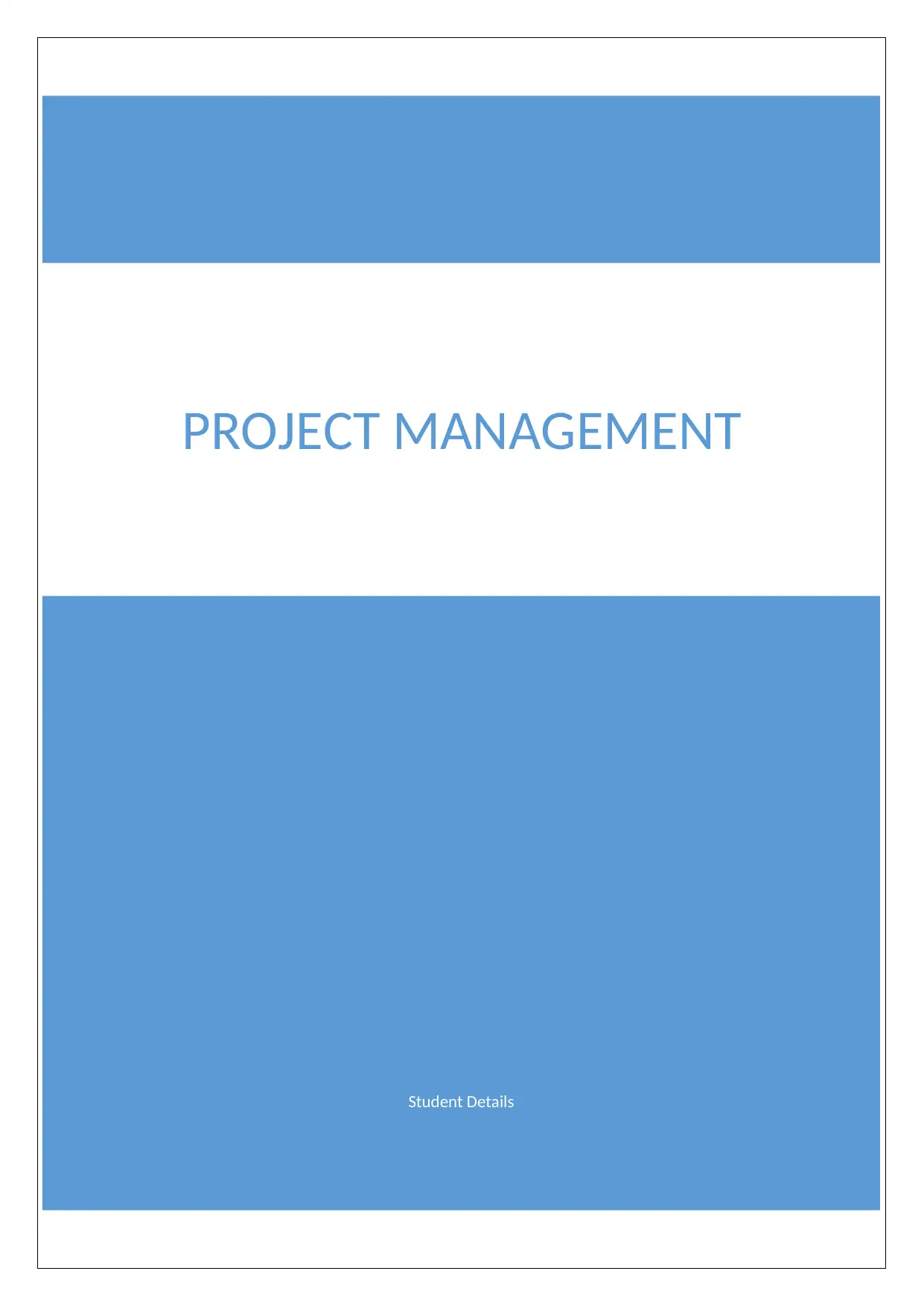
Student Details
PROJECT MANAGEMENT
PROJECT MANAGEMENT
Paraphrase This Document
Need a fresh take? Get an instant paraphrase of this document with our AI Paraphraser

Assessment 1: Essay
Contents
Introduction................................................................................................................................1
Analysis (Factors and Practices impacting the Project Success):..............................................1
Conclusion:................................................................................................................................4
References:.................................................................................................................................5
1
Contents
Introduction................................................................................................................................1
Analysis (Factors and Practices impacting the Project Success):..............................................1
Conclusion:................................................................................................................................4
References:.................................................................................................................................5
1

Assessment 1: Essay
Factors and Practices impacting the Project Success
Introduction
The fact that IT projects have experienced a terrible track record in terms of effective
completion is unarguable. From being unable to address the scope of the project to fail to
deliver the project on time, there are a number of reasons for the failure of IT projects. This
essay intends to highlight some of the key factors that have a significant impact on the
success of a project and how likely a project is to succeed under different circumstances.
Further, the essay intends to outline the different methods that can be used for selection of an
IT project and how it will impact the success chances for the same. Towards the end, the
essay aims to highlight the importance of virtual meetings and the related constraints in
managing projects which are outsourced overseas and how it will impact its success or
failure.
Analysis (Factors and Practices impacting the Project Success):
The undertaken project aims to develop an IT system or IMS for the client organization. The
key focus behind the development of the IMS is to bring in automation in the daily process
and operations of the organization. The target IMS will be used to replace their manual user
information system. Further, the IMS will allow the client organization to carry out a detailed
analysis in the information stored in the IMS and then use the same information for further
business process optimization. Following are the key Identified Tasks for the Project:
1. Information Gathering for Requirements
2. Requirement Analysis
3. Requirement Elicitation
4. Feasibility Study
5. Scope Planning
6. Development of SRS
7. Development of System Design
8. Implementation of System Design
9. Testing the Developed system
10. Scope Change Management
2
Factors and Practices impacting the Project Success
Introduction
The fact that IT projects have experienced a terrible track record in terms of effective
completion is unarguable. From being unable to address the scope of the project to fail to
deliver the project on time, there are a number of reasons for the failure of IT projects. This
essay intends to highlight some of the key factors that have a significant impact on the
success of a project and how likely a project is to succeed under different circumstances.
Further, the essay intends to outline the different methods that can be used for selection of an
IT project and how it will impact the success chances for the same. Towards the end, the
essay aims to highlight the importance of virtual meetings and the related constraints in
managing projects which are outsourced overseas and how it will impact its success or
failure.
Analysis (Factors and Practices impacting the Project Success):
The undertaken project aims to develop an IT system or IMS for the client organization. The
key focus behind the development of the IMS is to bring in automation in the daily process
and operations of the organization. The target IMS will be used to replace their manual user
information system. Further, the IMS will allow the client organization to carry out a detailed
analysis in the information stored in the IMS and then use the same information for further
business process optimization. Following are the key Identified Tasks for the Project:
1. Information Gathering for Requirements
2. Requirement Analysis
3. Requirement Elicitation
4. Feasibility Study
5. Scope Planning
6. Development of SRS
7. Development of System Design
8. Implementation of System Design
9. Testing the Developed system
10. Scope Change Management
2
⊘ This is a preview!⊘
Do you want full access?
Subscribe today to unlock all pages.

Trusted by 1+ million students worldwide
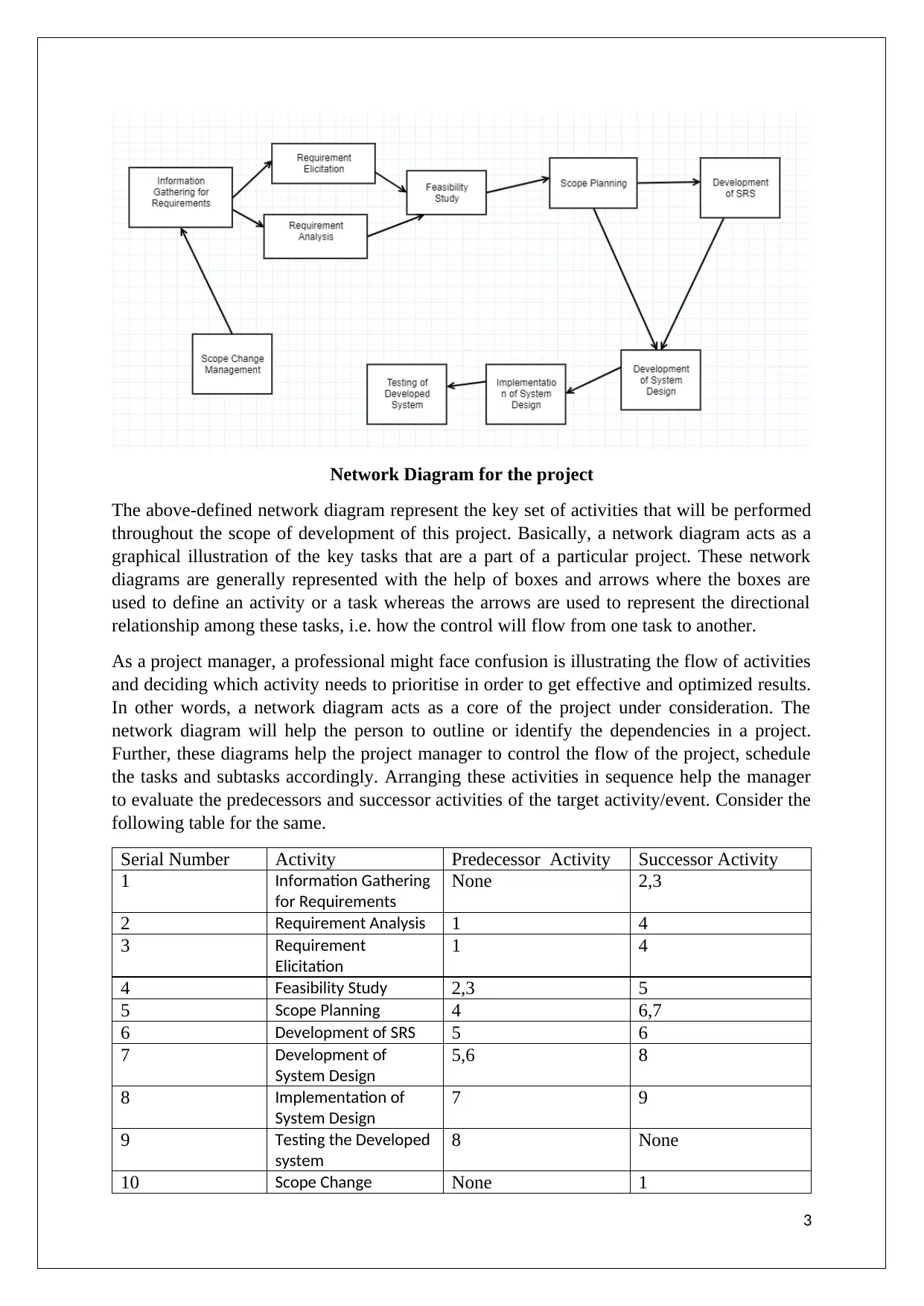
Network Diagram for the project
The above-defined network diagram represent the key set of activities that will be performed
throughout the scope of development of this project. Basically, a network diagram acts as a
graphical illustration of the key tasks that are a part of a particular project. These network
diagrams are generally represented with the help of boxes and arrows where the boxes are
used to define an activity or a task whereas the arrows are used to represent the directional
relationship among these tasks, i.e. how the control will flow from one task to another.
As a project manager, a professional might face confusion is illustrating the flow of activities
and deciding which activity needs to prioritise in order to get effective and optimized results.
In other words, a network diagram acts as a core of the project under consideration. The
network diagram will help the person to outline or identify the dependencies in a project.
Further, these diagrams help the project manager to control the flow of the project, schedule
the tasks and subtasks accordingly. Arranging these activities in sequence help the manager
to evaluate the predecessors and successor activities of the target activity/event. Consider the
following table for the same.
Serial Number Activity Predecessor Activity Successor Activity
1 Information Gathering
for Requirements
None 2,3
2 Requirement Analysis 1 4
3 Requirement
Elicitation
1 4
4 Feasibility Study 2,3 5
5 Scope Planning 4 6,7
6 Development of SRS 5 6
7 Development of
System Design
5,6 8
8 Implementation of
System Design
7 9
9 Testing the Developed
system
8 None
10 Scope Change None 1
3
The above-defined network diagram represent the key set of activities that will be performed
throughout the scope of development of this project. Basically, a network diagram acts as a
graphical illustration of the key tasks that are a part of a particular project. These network
diagrams are generally represented with the help of boxes and arrows where the boxes are
used to define an activity or a task whereas the arrows are used to represent the directional
relationship among these tasks, i.e. how the control will flow from one task to another.
As a project manager, a professional might face confusion is illustrating the flow of activities
and deciding which activity needs to prioritise in order to get effective and optimized results.
In other words, a network diagram acts as a core of the project under consideration. The
network diagram will help the person to outline or identify the dependencies in a project.
Further, these diagrams help the project manager to control the flow of the project, schedule
the tasks and subtasks accordingly. Arranging these activities in sequence help the manager
to evaluate the predecessors and successor activities of the target activity/event. Consider the
following table for the same.
Serial Number Activity Predecessor Activity Successor Activity
1 Information Gathering
for Requirements
None 2,3
2 Requirement Analysis 1 4
3 Requirement
Elicitation
1 4
4 Feasibility Study 2,3 5
5 Scope Planning 4 6,7
6 Development of SRS 5 6
7 Development of
System Design
5,6 8
8 Implementation of
System Design
7 9
9 Testing the Developed
system
8 None
10 Scope Change None 1
3
Paraphrase This Document
Need a fresh take? Get an instant paraphrase of this document with our AI Paraphraser
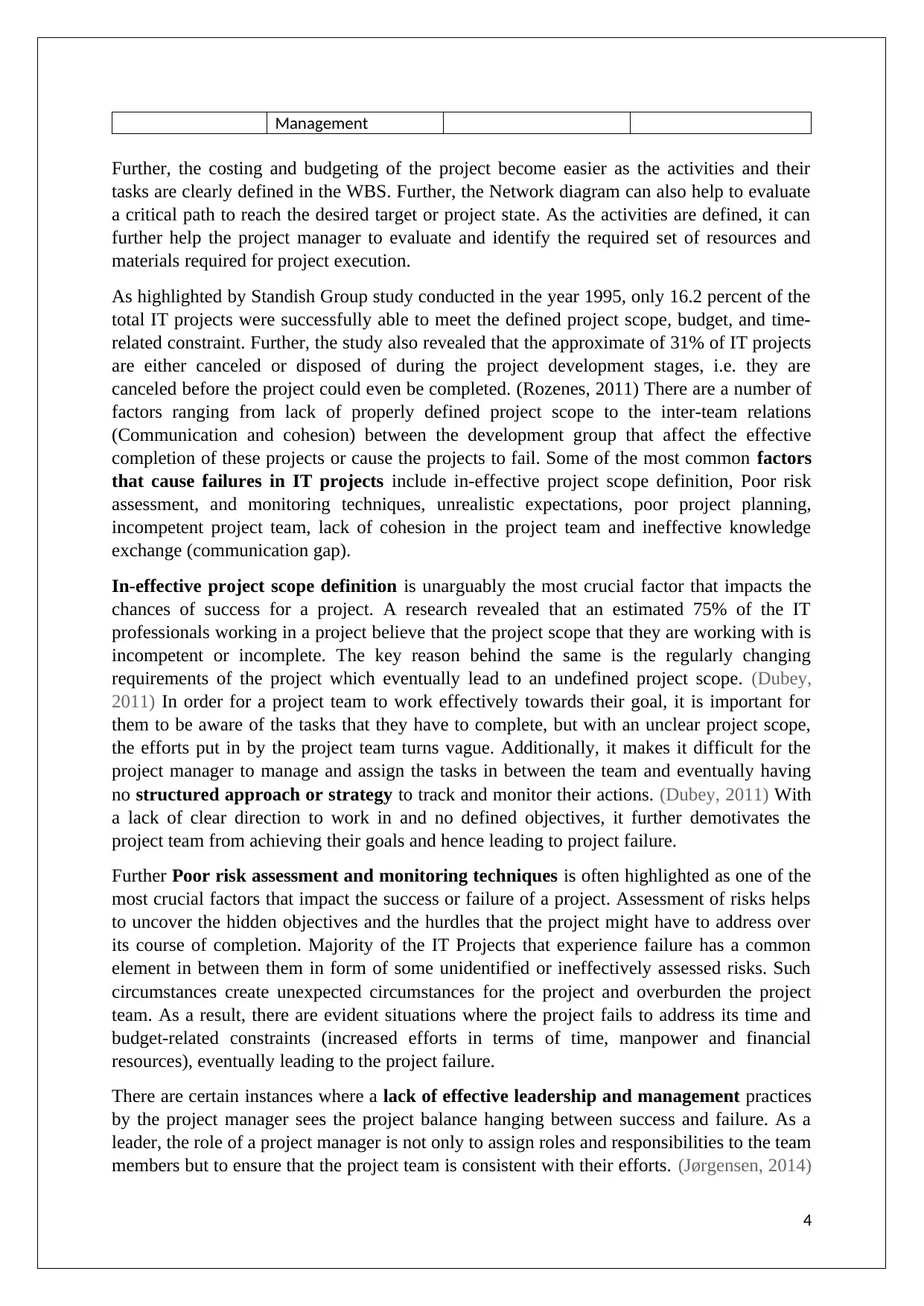
Management
Further, the costing and budgeting of the project become easier as the activities and their
tasks are clearly defined in the WBS. Further, the Network diagram can also help to evaluate
a critical path to reach the desired target or project state. As the activities are defined, it can
further help the project manager to evaluate and identify the required set of resources and
materials required for project execution.
As highlighted by Standish Group study conducted in the year 1995, only 16.2 percent of the
total IT projects were successfully able to meet the defined project scope, budget, and time-
related constraint. Further, the study also revealed that the approximate of 31% of IT projects
are either canceled or disposed of during the project development stages, i.e. they are
canceled before the project could even be completed. (Rozenes, 2011) There are a number of
factors ranging from lack of properly defined project scope to the inter-team relations
(Communication and cohesion) between the development group that affect the effective
completion of these projects or cause the projects to fail. Some of the most common factors
that cause failures in IT projects include in-effective project scope definition, Poor risk
assessment, and monitoring techniques, unrealistic expectations, poor project planning,
incompetent project team, lack of cohesion in the project team and ineffective knowledge
exchange (communication gap).
In-effective project scope definition is unarguably the most crucial factor that impacts the
chances of success for a project. A research revealed that an estimated 75% of the IT
professionals working in a project believe that the project scope that they are working with is
incompetent or incomplete. The key reason behind the same is the regularly changing
requirements of the project which eventually lead to an undefined project scope. (Dubey,
2011) In order for a project team to work effectively towards their goal, it is important for
them to be aware of the tasks that they have to complete, but with an unclear project scope,
the efforts put in by the project team turns vague. Additionally, it makes it difficult for the
project manager to manage and assign the tasks in between the team and eventually having
no structured approach or strategy to track and monitor their actions. (Dubey, 2011) With
a lack of clear direction to work in and no defined objectives, it further demotivates the
project team from achieving their goals and hence leading to project failure.
Further Poor risk assessment and monitoring techniques is often highlighted as one of the
most crucial factors that impact the success or failure of a project. Assessment of risks helps
to uncover the hidden objectives and the hurdles that the project might have to address over
its course of completion. Majority of the IT Projects that experience failure has a common
element in between them in form of some unidentified or ineffectively assessed risks. Such
circumstances create unexpected circumstances for the project and overburden the project
team. As a result, there are evident situations where the project fails to address its time and
budget-related constraints (increased efforts in terms of time, manpower and financial
resources), eventually leading to the project failure.
There are certain instances where a lack of effective leadership and management practices
by the project manager sees the project balance hanging between success and failure. As a
leader, the role of a project manager is not only to assign roles and responsibilities to the team
members but to ensure that the project team is consistent with their efforts. (Jørgensen, 2014)
4
Further, the costing and budgeting of the project become easier as the activities and their
tasks are clearly defined in the WBS. Further, the Network diagram can also help to evaluate
a critical path to reach the desired target or project state. As the activities are defined, it can
further help the project manager to evaluate and identify the required set of resources and
materials required for project execution.
As highlighted by Standish Group study conducted in the year 1995, only 16.2 percent of the
total IT projects were successfully able to meet the defined project scope, budget, and time-
related constraint. Further, the study also revealed that the approximate of 31% of IT projects
are either canceled or disposed of during the project development stages, i.e. they are
canceled before the project could even be completed. (Rozenes, 2011) There are a number of
factors ranging from lack of properly defined project scope to the inter-team relations
(Communication and cohesion) between the development group that affect the effective
completion of these projects or cause the projects to fail. Some of the most common factors
that cause failures in IT projects include in-effective project scope definition, Poor risk
assessment, and monitoring techniques, unrealistic expectations, poor project planning,
incompetent project team, lack of cohesion in the project team and ineffective knowledge
exchange (communication gap).
In-effective project scope definition is unarguably the most crucial factor that impacts the
chances of success for a project. A research revealed that an estimated 75% of the IT
professionals working in a project believe that the project scope that they are working with is
incompetent or incomplete. The key reason behind the same is the regularly changing
requirements of the project which eventually lead to an undefined project scope. (Dubey,
2011) In order for a project team to work effectively towards their goal, it is important for
them to be aware of the tasks that they have to complete, but with an unclear project scope,
the efforts put in by the project team turns vague. Additionally, it makes it difficult for the
project manager to manage and assign the tasks in between the team and eventually having
no structured approach or strategy to track and monitor their actions. (Dubey, 2011) With
a lack of clear direction to work in and no defined objectives, it further demotivates the
project team from achieving their goals and hence leading to project failure.
Further Poor risk assessment and monitoring techniques is often highlighted as one of the
most crucial factors that impact the success or failure of a project. Assessment of risks helps
to uncover the hidden objectives and the hurdles that the project might have to address over
its course of completion. Majority of the IT Projects that experience failure has a common
element in between them in form of some unidentified or ineffectively assessed risks. Such
circumstances create unexpected circumstances for the project and overburden the project
team. As a result, there are evident situations where the project fails to address its time and
budget-related constraints (increased efforts in terms of time, manpower and financial
resources), eventually leading to the project failure.
There are certain instances where a lack of effective leadership and management practices
by the project manager sees the project balance hanging between success and failure. As a
leader, the role of a project manager is not only to assign roles and responsibilities to the team
members but to ensure that the project team is consistent with their efforts. (Jørgensen, 2014)
4
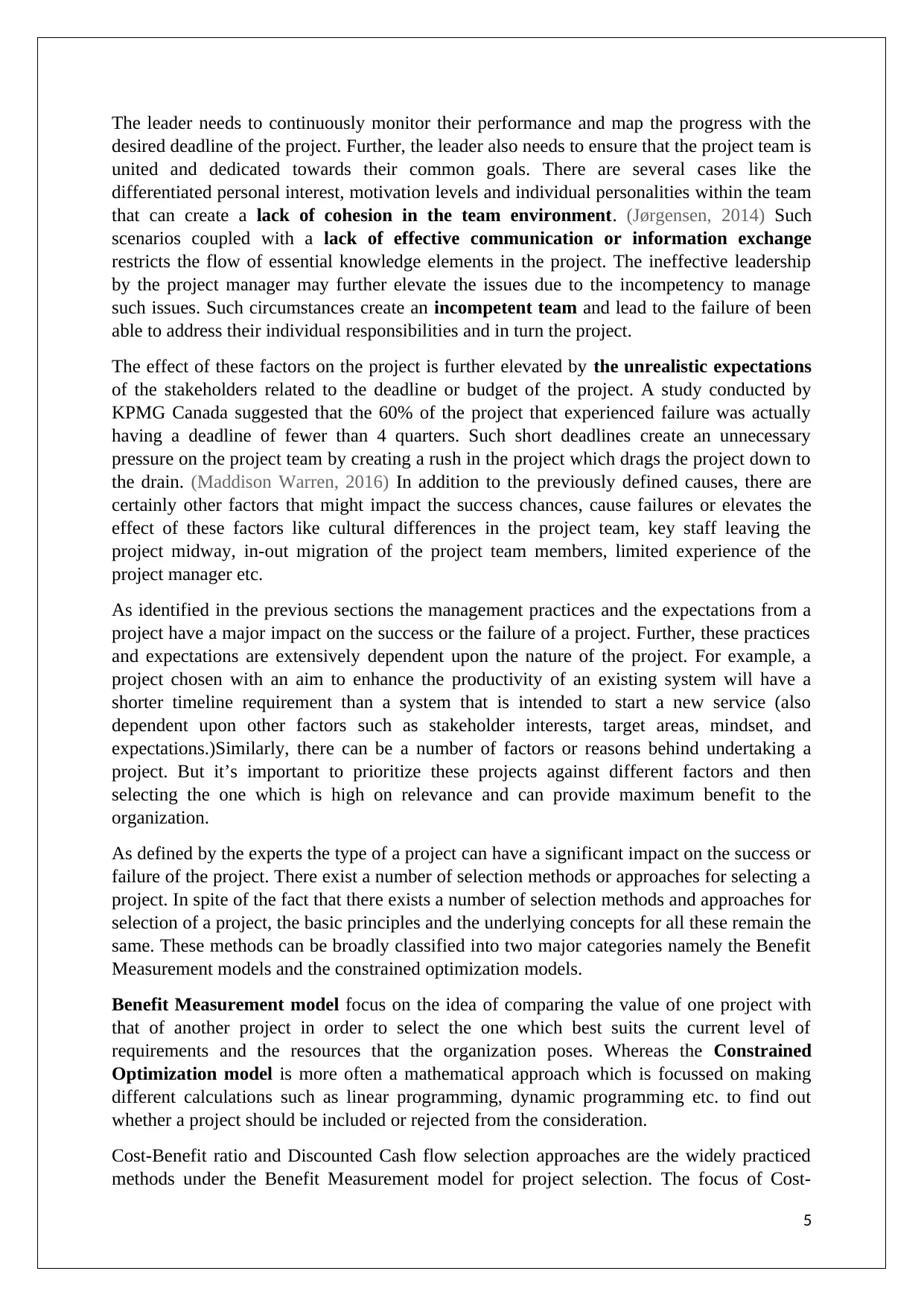
The leader needs to continuously monitor their performance and map the progress with the
desired deadline of the project. Further, the leader also needs to ensure that the project team is
united and dedicated towards their common goals. There are several cases like the
differentiated personal interest, motivation levels and individual personalities within the team
that can create a lack of cohesion in the team environment. (Jørgensen, 2014) Such
scenarios coupled with a lack of effective communication or information exchange
restricts the flow of essential knowledge elements in the project. The ineffective leadership
by the project manager may further elevate the issues due to the incompetency to manage
such issues. Such circumstances create an incompetent team and lead to the failure of been
able to address their individual responsibilities and in turn the project.
The effect of these factors on the project is further elevated by the unrealistic expectations
of the stakeholders related to the deadline or budget of the project. A study conducted by
KPMG Canada suggested that the 60% of the project that experienced failure was actually
having a deadline of fewer than 4 quarters. Such short deadlines create an unnecessary
pressure on the project team by creating a rush in the project which drags the project down to
the drain. (Maddison Warren, 2016) In addition to the previously defined causes, there are
certainly other factors that might impact the success chances, cause failures or elevates the
effect of these factors like cultural differences in the project team, key staff leaving the
project midway, in-out migration of the project team members, limited experience of the
project manager etc.
As identified in the previous sections the management practices and the expectations from a
project have a major impact on the success or the failure of a project. Further, these practices
and expectations are extensively dependent upon the nature of the project. For example, a
project chosen with an aim to enhance the productivity of an existing system will have a
shorter timeline requirement than a system that is intended to start a new service (also
dependent upon other factors such as stakeholder interests, target areas, mindset, and
expectations.)Similarly, there can be a number of factors or reasons behind undertaking a
project. But it’s important to prioritize these projects against different factors and then
selecting the one which is high on relevance and can provide maximum benefit to the
organization.
As defined by the experts the type of a project can have a significant impact on the success or
failure of the project. There exist a number of selection methods or approaches for selecting a
project. In spite of the fact that there exists a number of selection methods and approaches for
selection of a project, the basic principles and the underlying concepts for all these remain the
same. These methods can be broadly classified into two major categories namely the Benefit
Measurement models and the constrained optimization models.
Benefit Measurement model focus on the idea of comparing the value of one project with
that of another project in order to select the one which best suits the current level of
requirements and the resources that the organization poses. Whereas the Constrained
Optimization model is more often a mathematical approach which is focussed on making
different calculations such as linear programming, dynamic programming etc. to find out
whether a project should be included or rejected from the consideration.
Cost-Benefit ratio and Discounted Cash flow selection approaches are the widely practiced
methods under the Benefit Measurement model for project selection. The focus of Cost-
5
desired deadline of the project. Further, the leader also needs to ensure that the project team is
united and dedicated towards their common goals. There are several cases like the
differentiated personal interest, motivation levels and individual personalities within the team
that can create a lack of cohesion in the team environment. (Jørgensen, 2014) Such
scenarios coupled with a lack of effective communication or information exchange
restricts the flow of essential knowledge elements in the project. The ineffective leadership
by the project manager may further elevate the issues due to the incompetency to manage
such issues. Such circumstances create an incompetent team and lead to the failure of been
able to address their individual responsibilities and in turn the project.
The effect of these factors on the project is further elevated by the unrealistic expectations
of the stakeholders related to the deadline or budget of the project. A study conducted by
KPMG Canada suggested that the 60% of the project that experienced failure was actually
having a deadline of fewer than 4 quarters. Such short deadlines create an unnecessary
pressure on the project team by creating a rush in the project which drags the project down to
the drain. (Maddison Warren, 2016) In addition to the previously defined causes, there are
certainly other factors that might impact the success chances, cause failures or elevates the
effect of these factors like cultural differences in the project team, key staff leaving the
project midway, in-out migration of the project team members, limited experience of the
project manager etc.
As identified in the previous sections the management practices and the expectations from a
project have a major impact on the success or the failure of a project. Further, these practices
and expectations are extensively dependent upon the nature of the project. For example, a
project chosen with an aim to enhance the productivity of an existing system will have a
shorter timeline requirement than a system that is intended to start a new service (also
dependent upon other factors such as stakeholder interests, target areas, mindset, and
expectations.)Similarly, there can be a number of factors or reasons behind undertaking a
project. But it’s important to prioritize these projects against different factors and then
selecting the one which is high on relevance and can provide maximum benefit to the
organization.
As defined by the experts the type of a project can have a significant impact on the success or
failure of the project. There exist a number of selection methods or approaches for selecting a
project. In spite of the fact that there exists a number of selection methods and approaches for
selection of a project, the basic principles and the underlying concepts for all these remain the
same. These methods can be broadly classified into two major categories namely the Benefit
Measurement models and the constrained optimization models.
Benefit Measurement model focus on the idea of comparing the value of one project with
that of another project in order to select the one which best suits the current level of
requirements and the resources that the organization poses. Whereas the Constrained
Optimization model is more often a mathematical approach which is focussed on making
different calculations such as linear programming, dynamic programming etc. to find out
whether a project should be included or rejected from the consideration.
Cost-Benefit ratio and Discounted Cash flow selection approaches are the widely practiced
methods under the Benefit Measurement model for project selection. The focus of Cost-
5
⊘ This is a preview!⊘
Do you want full access?
Subscribe today to unlock all pages.

Trusted by 1+ million students worldwide
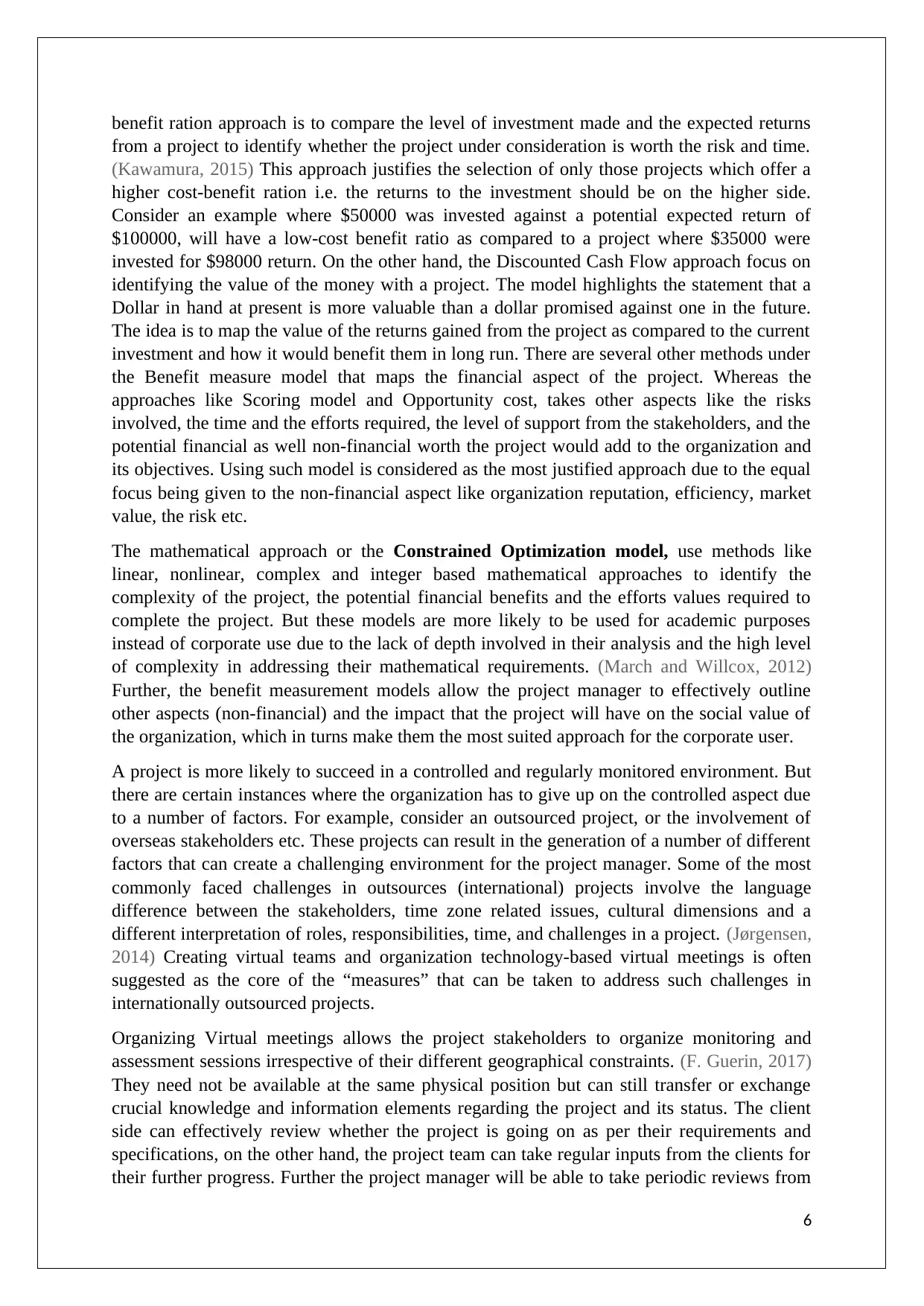
benefit ration approach is to compare the level of investment made and the expected returns
from a project to identify whether the project under consideration is worth the risk and time.
(Kawamura, 2015) This approach justifies the selection of only those projects which offer a
higher cost-benefit ration i.e. the returns to the investment should be on the higher side.
Consider an example where $50000 was invested against a potential expected return of
$100000, will have a low-cost benefit ratio as compared to a project where $35000 were
invested for $98000 return. On the other hand, the Discounted Cash Flow approach focus on
identifying the value of the money with a project. The model highlights the statement that a
Dollar in hand at present is more valuable than a dollar promised against one in the future.
The idea is to map the value of the returns gained from the project as compared to the current
investment and how it would benefit them in long run. There are several other methods under
the Benefit measure model that maps the financial aspect of the project. Whereas the
approaches like Scoring model and Opportunity cost, takes other aspects like the risks
involved, the time and the efforts required, the level of support from the stakeholders, and the
potential financial as well non-financial worth the project would add to the organization and
its objectives. Using such model is considered as the most justified approach due to the equal
focus being given to the non-financial aspect like organization reputation, efficiency, market
value, the risk etc.
The mathematical approach or the Constrained Optimization model, use methods like
linear, nonlinear, complex and integer based mathematical approaches to identify the
complexity of the project, the potential financial benefits and the efforts values required to
complete the project. But these models are more likely to be used for academic purposes
instead of corporate use due to the lack of depth involved in their analysis and the high level
of complexity in addressing their mathematical requirements. (March and Willcox, 2012)
Further, the benefit measurement models allow the project manager to effectively outline
other aspects (non-financial) and the impact that the project will have on the social value of
the organization, which in turns make them the most suited approach for the corporate user.
A project is more likely to succeed in a controlled and regularly monitored environment. But
there are certain instances where the organization has to give up on the controlled aspect due
to a number of factors. For example, consider an outsourced project, or the involvement of
overseas stakeholders etc. These projects can result in the generation of a number of different
factors that can create a challenging environment for the project manager. Some of the most
commonly faced challenges in outsources (international) projects involve the language
difference between the stakeholders, time zone related issues, cultural dimensions and a
different interpretation of roles, responsibilities, time, and challenges in a project. (Jørgensen,
2014) Creating virtual teams and organization technology-based virtual meetings is often
suggested as the core of the “measures” that can be taken to address such challenges in
internationally outsourced projects.
Organizing Virtual meetings allows the project stakeholders to organize monitoring and
assessment sessions irrespective of their different geographical constraints. (F. Guerin, 2017)
They need not be available at the same physical position but can still transfer or exchange
crucial knowledge and information elements regarding the project and its status. The client
side can effectively review whether the project is going on as per their requirements and
specifications, on the other hand, the project team can take regular inputs from the clients for
their further progress. Further the project manager will be able to take periodic reviews from
6
from a project to identify whether the project under consideration is worth the risk and time.
(Kawamura, 2015) This approach justifies the selection of only those projects which offer a
higher cost-benefit ration i.e. the returns to the investment should be on the higher side.
Consider an example where $50000 was invested against a potential expected return of
$100000, will have a low-cost benefit ratio as compared to a project where $35000 were
invested for $98000 return. On the other hand, the Discounted Cash Flow approach focus on
identifying the value of the money with a project. The model highlights the statement that a
Dollar in hand at present is more valuable than a dollar promised against one in the future.
The idea is to map the value of the returns gained from the project as compared to the current
investment and how it would benefit them in long run. There are several other methods under
the Benefit measure model that maps the financial aspect of the project. Whereas the
approaches like Scoring model and Opportunity cost, takes other aspects like the risks
involved, the time and the efforts required, the level of support from the stakeholders, and the
potential financial as well non-financial worth the project would add to the organization and
its objectives. Using such model is considered as the most justified approach due to the equal
focus being given to the non-financial aspect like organization reputation, efficiency, market
value, the risk etc.
The mathematical approach or the Constrained Optimization model, use methods like
linear, nonlinear, complex and integer based mathematical approaches to identify the
complexity of the project, the potential financial benefits and the efforts values required to
complete the project. But these models are more likely to be used for academic purposes
instead of corporate use due to the lack of depth involved in their analysis and the high level
of complexity in addressing their mathematical requirements. (March and Willcox, 2012)
Further, the benefit measurement models allow the project manager to effectively outline
other aspects (non-financial) and the impact that the project will have on the social value of
the organization, which in turns make them the most suited approach for the corporate user.
A project is more likely to succeed in a controlled and regularly monitored environment. But
there are certain instances where the organization has to give up on the controlled aspect due
to a number of factors. For example, consider an outsourced project, or the involvement of
overseas stakeholders etc. These projects can result in the generation of a number of different
factors that can create a challenging environment for the project manager. Some of the most
commonly faced challenges in outsources (international) projects involve the language
difference between the stakeholders, time zone related issues, cultural dimensions and a
different interpretation of roles, responsibilities, time, and challenges in a project. (Jørgensen,
2014) Creating virtual teams and organization technology-based virtual meetings is often
suggested as the core of the “measures” that can be taken to address such challenges in
internationally outsourced projects.
Organizing Virtual meetings allows the project stakeholders to organize monitoring and
assessment sessions irrespective of their different geographical constraints. (F. Guerin, 2017)
They need not be available at the same physical position but can still transfer or exchange
crucial knowledge and information elements regarding the project and its status. The client
side can effectively review whether the project is going on as per their requirements and
specifications, on the other hand, the project team can take regular inputs from the clients for
their further progress. Further the project manager will be able to take periodic reviews from
6
Paraphrase This Document
Need a fresh take? Get an instant paraphrase of this document with our AI Paraphraser
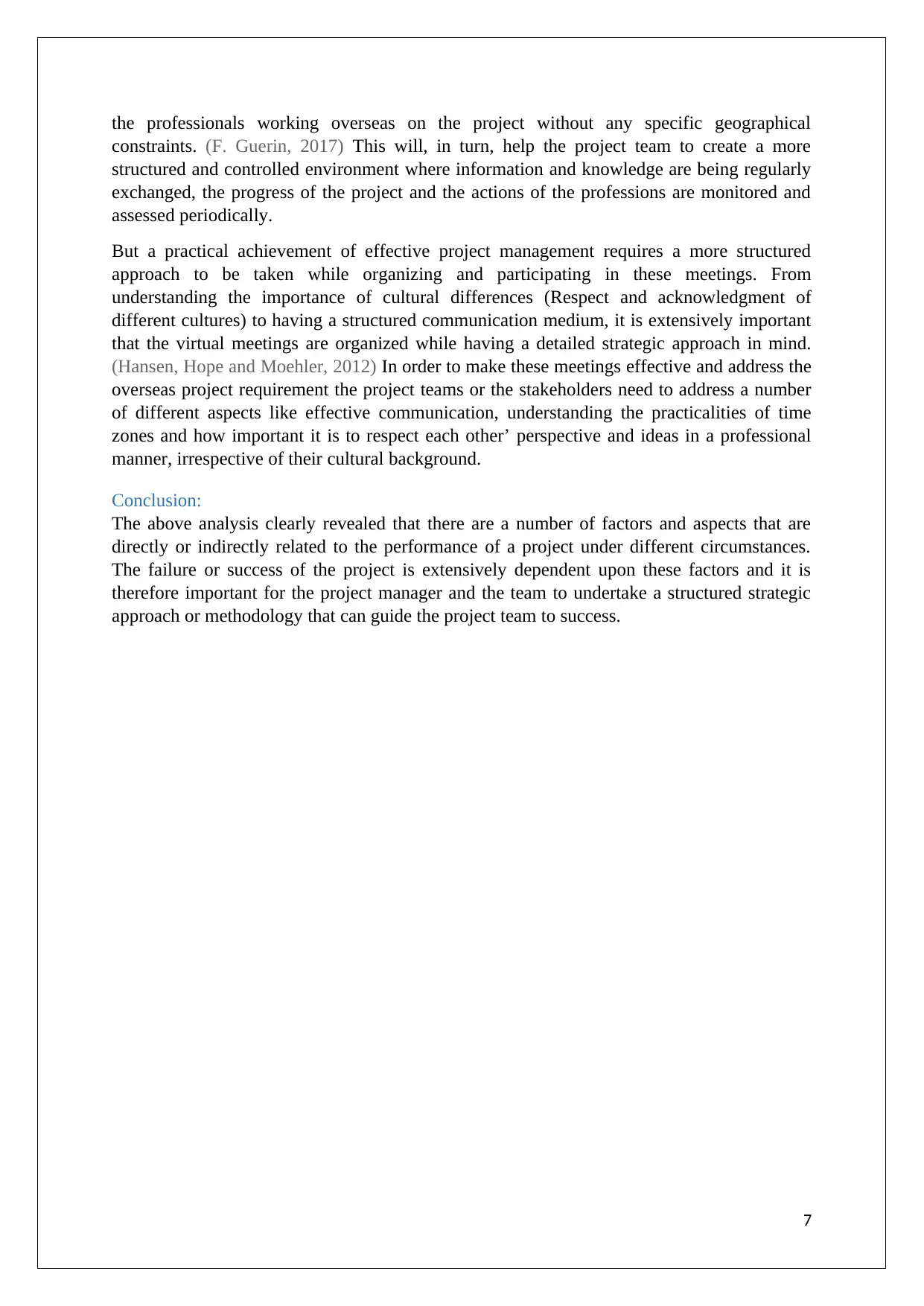
the professionals working overseas on the project without any specific geographical
constraints. (F. Guerin, 2017) This will, in turn, help the project team to create a more
structured and controlled environment where information and knowledge are being regularly
exchanged, the progress of the project and the actions of the professions are monitored and
assessed periodically.
But a practical achievement of effective project management requires a more structured
approach to be taken while organizing and participating in these meetings. From
understanding the importance of cultural differences (Respect and acknowledgment of
different cultures) to having a structured communication medium, it is extensively important
that the virtual meetings are organized while having a detailed strategic approach in mind.
(Hansen, Hope and Moehler, 2012) In order to make these meetings effective and address the
overseas project requirement the project teams or the stakeholders need to address a number
of different aspects like effective communication, understanding the practicalities of time
zones and how important it is to respect each other’ perspective and ideas in a professional
manner, irrespective of their cultural background.
Conclusion:
The above analysis clearly revealed that there are a number of factors and aspects that are
directly or indirectly related to the performance of a project under different circumstances.
The failure or success of the project is extensively dependent upon these factors and it is
therefore important for the project manager and the team to undertake a structured strategic
approach or methodology that can guide the project team to success.
7
constraints. (F. Guerin, 2017) This will, in turn, help the project team to create a more
structured and controlled environment where information and knowledge are being regularly
exchanged, the progress of the project and the actions of the professions are monitored and
assessed periodically.
But a practical achievement of effective project management requires a more structured
approach to be taken while organizing and participating in these meetings. From
understanding the importance of cultural differences (Respect and acknowledgment of
different cultures) to having a structured communication medium, it is extensively important
that the virtual meetings are organized while having a detailed strategic approach in mind.
(Hansen, Hope and Moehler, 2012) In order to make these meetings effective and address the
overseas project requirement the project teams or the stakeholders need to address a number
of different aspects like effective communication, understanding the practicalities of time
zones and how important it is to respect each other’ perspective and ideas in a professional
manner, irrespective of their cultural background.
Conclusion:
The above analysis clearly revealed that there are a number of factors and aspects that are
directly or indirectly related to the performance of a project under different circumstances.
The failure or success of the project is extensively dependent upon these factors and it is
therefore important for the project manager and the team to undertake a structured strategic
approach or methodology that can guide the project team to success.
7
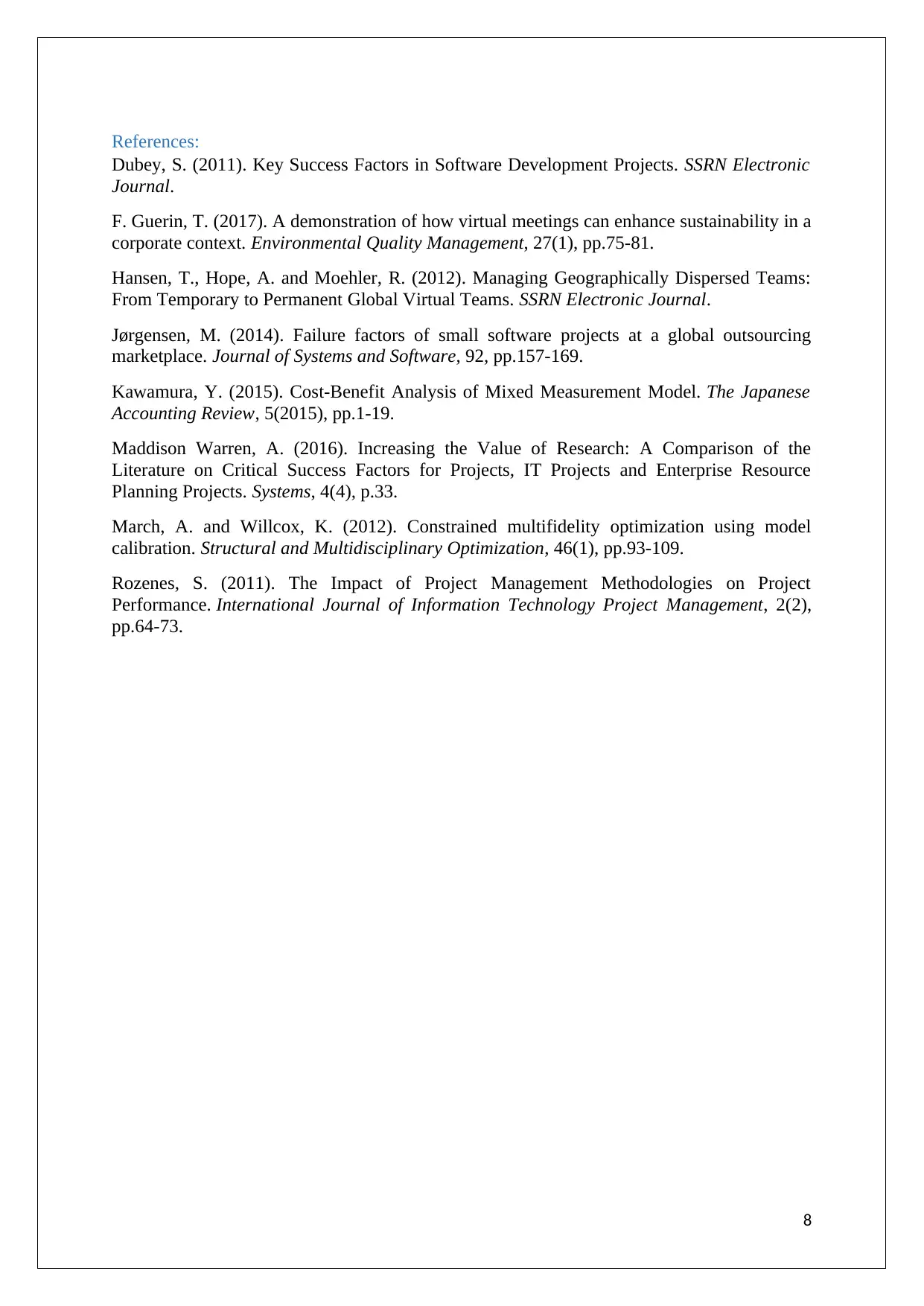
References:
Dubey, S. (2011). Key Success Factors in Software Development Projects. SSRN Electronic
Journal.
F. Guerin, T. (2017). A demonstration of how virtual meetings can enhance sustainability in a
corporate context. Environmental Quality Management, 27(1), pp.75-81.
Hansen, T., Hope, A. and Moehler, R. (2012). Managing Geographically Dispersed Teams:
From Temporary to Permanent Global Virtual Teams. SSRN Electronic Journal.
Jørgensen, M. (2014). Failure factors of small software projects at a global outsourcing
marketplace. Journal of Systems and Software, 92, pp.157-169.
Kawamura, Y. (2015). Cost-Benefit Analysis of Mixed Measurement Model. The Japanese
Accounting Review, 5(2015), pp.1-19.
Maddison Warren, A. (2016). Increasing the Value of Research: A Comparison of the
Literature on Critical Success Factors for Projects, IT Projects and Enterprise Resource
Planning Projects. Systems, 4(4), p.33.
March, A. and Willcox, K. (2012). Constrained multifidelity optimization using model
calibration. Structural and Multidisciplinary Optimization, 46(1), pp.93-109.
Rozenes, S. (2011). The Impact of Project Management Methodologies on Project
Performance. International Journal of Information Technology Project Management, 2(2),
pp.64-73.
8
Dubey, S. (2011). Key Success Factors in Software Development Projects. SSRN Electronic
Journal.
F. Guerin, T. (2017). A demonstration of how virtual meetings can enhance sustainability in a
corporate context. Environmental Quality Management, 27(1), pp.75-81.
Hansen, T., Hope, A. and Moehler, R. (2012). Managing Geographically Dispersed Teams:
From Temporary to Permanent Global Virtual Teams. SSRN Electronic Journal.
Jørgensen, M. (2014). Failure factors of small software projects at a global outsourcing
marketplace. Journal of Systems and Software, 92, pp.157-169.
Kawamura, Y. (2015). Cost-Benefit Analysis of Mixed Measurement Model. The Japanese
Accounting Review, 5(2015), pp.1-19.
Maddison Warren, A. (2016). Increasing the Value of Research: A Comparison of the
Literature on Critical Success Factors for Projects, IT Projects and Enterprise Resource
Planning Projects. Systems, 4(4), p.33.
March, A. and Willcox, K. (2012). Constrained multifidelity optimization using model
calibration. Structural and Multidisciplinary Optimization, 46(1), pp.93-109.
Rozenes, S. (2011). The Impact of Project Management Methodologies on Project
Performance. International Journal of Information Technology Project Management, 2(2),
pp.64-73.
8
⊘ This is a preview!⊘
Do you want full access?
Subscribe today to unlock all pages.

Trusted by 1+ million students worldwide

9
1 out of 10
Related Documents
Your All-in-One AI-Powered Toolkit for Academic Success.
+13062052269
info@desklib.com
Available 24*7 on WhatsApp / Email
![[object Object]](/_next/static/media/star-bottom.7253800d.svg)
Unlock your academic potential
Copyright © 2020–2025 A2Z Services. All Rights Reserved. Developed and managed by ZUCOL.




